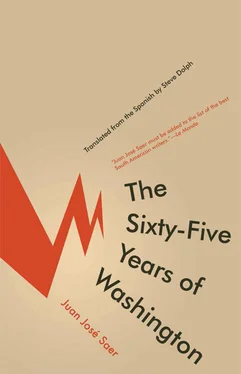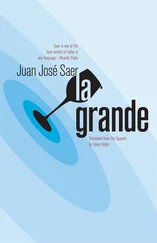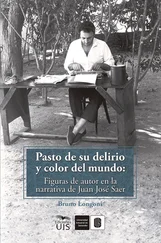This could be, according to the Mathematician, no? R = (R, naturally, for reality). Reality equals — and this capital R , the Mathematician reasons, should correspond to an expression describing it so exhaustively and rigorously that whenever the word is used all of the perfectly identified terms of the equation would be automatically implied. The first term is him — the Mathematician, no? — not a given as an individual, but as a constant in the equation, a subject S , a structured and transitory but at the same time invariable moment of possibility for conceiving the equation; and to resist the interpretation of a plurality of equivalent moments to the cognitive act, he decides to add a lowercase s so that the plurality of the subject — which could be the Mathematician or anyone else on the street right then or anywhere else or at any other time — is a constant included in the term. You would have, therefore, the Mathematician tells himself, R = Ss , for starters. But wouldn’t it be too naïve to put Ss before an object O , as though they were antagonistic and the juxtaposition an overly simple operation that destroys the unity that exists between them? Ultimately, yes, bearing in mind that Ss , as a subject of the equation, is already implied in O , the object he intends to formalize. In that case Ss O constitutes an entity. This entity can be referred to as x , which gives R = x (SsO). Elegant , thinks the Mathematician. But his entity immediately falls apart: if there is a distinction in Ss , the lowercase specifying the transindividual order of the S , the capital O on the contrary does not distinguish among its different components, of which S and Ss are not the least important — in O you have to include Ss not as the subject of the equation, but as an objective component of O , where all of the contingent objects that are not O are also included in the universal and all-inclusive objects S, Ss , and O , if a lowercase o designates the multiplicity of contingent objects that compose it. This gives R = x SsO (S Ss O) . . On the other hand, the heterogeneous and contingent designation of the lowercase o , that is to say the concrete moments of O , also present several complications, given that its number, function, nature, etc., can be determinant or indeterminate — the Mathematician continues, no? — meaning you would have to designate its determination and indetermination at the same time, since if they are designated by their determinant, an indefinite number of its attributes would not be included in its definition. But since S and Ss , as objects, are not free of indetermination, instead of writing o n it would be more exact, the Mathematician tells himself, to formulate it the following way: R = x SsO (S Ss o) n— and so on, or rather, to be more precise, more or less.
Leto observes that the Mathematician is walking with his eyes half closed and wearing a pensive smile that he attributes to some kind of rhythmic test he set for himself, or for Leto maybe, as if, concentrating, he was preparing to adapt himself to any change in rhythm, velocity or even trajectory that Leto, unexpectedly, might decide to employ. In any case, this is what Leto interprets in his expression, and accepting the challenge he imagines in the Mathematician’s face, he accelerates a little more, so unexpectedly that that Mathematician, whose modest person is trying to formulate an equation — valid forever, anywhere, in any language — to once and for all substitute the word reality with a more manageable tool for thought, reciprocates the acceleration without turning his head and, changing his stride, as though marching, adapts to Leto’s pace. Unfortunately, the ekstasis , more akin to animal pleasures than complex abstractions, vacates once again from the equation, and his whole body prepares for possible approaching changes, while above, inside his head, the fragile distinctions that as pure diversion he has been trying to sort through, are demolished by the muscular effort and silently fall apart.
Thanks to years of training on rugby fields, the Mathematician could easily, if he wanted, with a few vigorous strides, overtake Leto who, because of his shorter and less prepared legs, would need to supply extra effort to follow him, but, actually, he doesn’t want to, and he allows Leto to lead, forcing him into a contradictory effort intended to mitigate rather than impel the force of his stride, and so each of his steps is measured and careful — fruit, as they say, of a controlled energy that produces more aesthetic and, you could say, moral satisfaction in him than a continuous acceleration, taking him to the limit of his strength, would produce, in a race, for example, and after a few seconds he adapts so well to the effort, matching the imperceptible but constant increase in velocity that Leto adds to the walk, that the idea of an equation to stand, in any language, time, or place, for the word reality appears again obstinately but in the form of euphoric convictions or visions that follow one after another in the lucid part of his mind: It’s the visible plus the invisible. In every state. Me plus everything that’s not me. This street plus everything that’s not this street. Everything in all its states , thinks the Mathematician, somewhat self-exultant, and in order to see the street in a different state from the one he is seeing, he turns his head, without modulating the rhythm of his stride at all, and starts to look, over his left shoulder, at the street they have been leaving behind. Leto, tense and vigilant, observes all of these gestures out of what they call the corner of his eye, puts on a rigid grin when he perceives the head turn and, very slowly, as though it were something millimetric and ritual, copies the movement. The Mathematician, who likewise notices, waits a few seconds while they take two or three steps and, to take Leto by surprise and make him hesitate, continues, with the rest of his body, the turn he had just made with his head only, without interrupting his walk, so that now his whole body is facing the part of the street they have already traveled and the Mathematician continues as before, but walking backward. Leto carries out the same movement with a fraction of a second’s difference, satisfied by his quick adaptation to the Mathematician’s inexplicable whim. Upright and even more tense because of the unnaturalness of their movement, rhythmically and cautiously in reverse, they arrive, without realizing, at the intersection, underestimating the disturbance that their singular attitude is causing in the people passing them. Two or three have to step aside to avoid a collision. From the sidewalks, others look at them with surprise, with indignation, or with an incredulous and condescending smile. An old man stops and looks after them, shaking his head reprovingly. But they ignore them, less so out of insensitivity than because of the extreme concentration their walk demands, and most of all because, whether or not they think it in words, the straight street they are leaving behind is made of themselves, of their lives, is inconceivable without them, without their lives, and as they walk it forms along with the movement — it’s the empirical edge of the occurrence, ubiquitous and mobile, which they take with them wherever they go, the shape the world takes when it gives in to the finite, the street, morning, color, matter, and movement — all of that, let us be clear so it’s well understood, more or less, and if you like, while it’s always the Same, no? and in the Same always, as I was saying, but after all, and above all, what’s the difference!
Читать дальше












